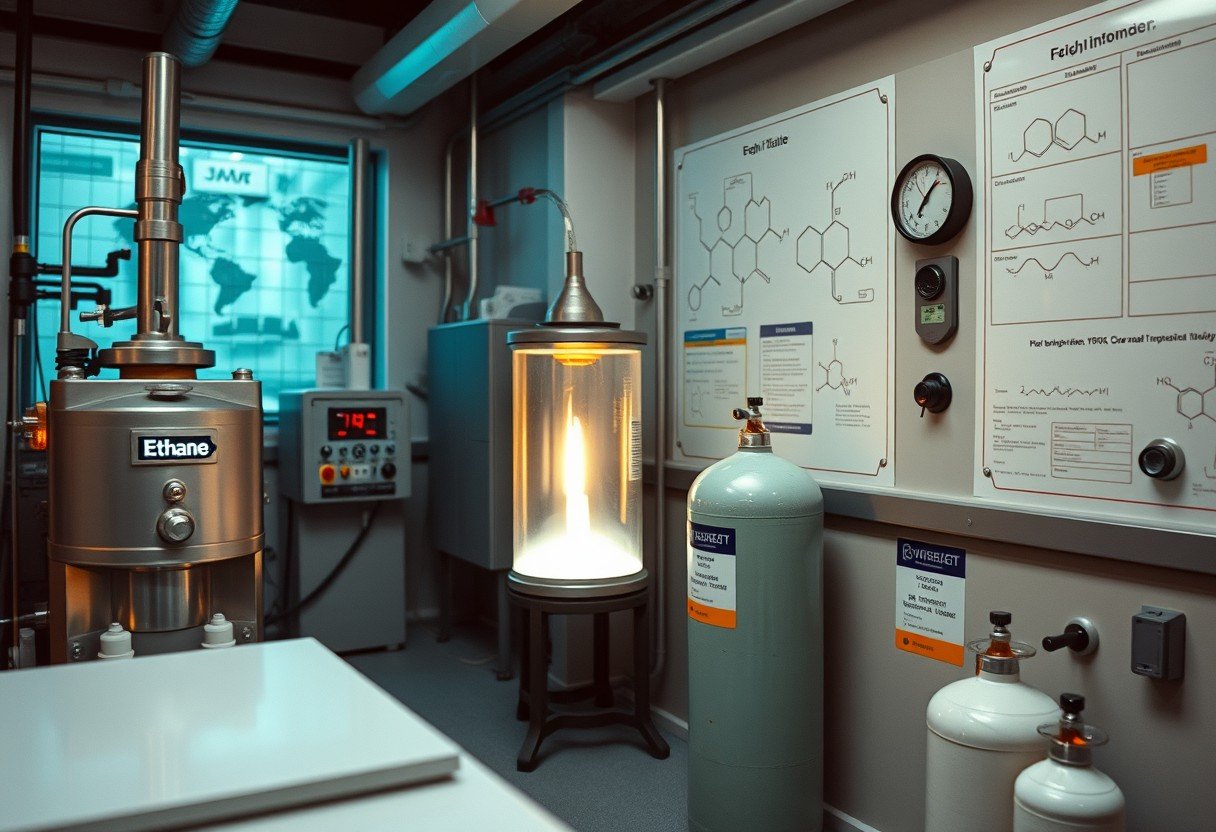Ethane, C2H6, is a common hydrocarbon found in natural gas, and understanding its energy properties is vital. The heat of combustion of ethane tells us exactly how much energy is released when it’s burned completely with oxygen. This value, around 1560 kilojoules per mole, is crucial for everything from energy production to assessing the environmental impact of fuels. It helps explain why ethane is such a useful fuel source in various industries.
What is the Heat of Combustion?
The heat of combustion is a measurement of the total energy released as heat when a substance undergoes complete combustion with oxygen. For a fuel like ethane, this reaction produces carbon dioxide and water. The value is typically expressed in kilojoules per mole (kJ/mol).
This process is what is known as an exothermic reaction. An exothermic reaction is one that releases energy into the surroundings, usually in the form of heat. This is why burning fuels like ethane can be used to generate power or provide heat for homes and industries. The higher the heat of combustion, the more energy the fuel can provide.
To get an accurate measurement, scientists use a technique called combustion calorimetry. A device known as a bomb calorimeter is used to burn a small, known amount of the substance in a controlled environment. By measuring the temperature change of the surrounding water, they can precisely calculate the heat energy released during the reaction.
A Closer Look at Ethane (C2H6)
Ethane is a simple hydrocarbon with the chemical formula C2H6. It is a colorless and odorless gas at standard temperature and pressure. As an alkane, its structure consists of two carbon atoms connected by a single bond, with six hydrogen atoms attached. This simple, saturated structure makes it relatively stable but also highly flammable.
The main sources of ethane are natural gas and crude oil reserves. It is separated from other hydrocarbons during natural gas processing. While it is a valuable fuel, one of its most significant roles is in the petrochemical industry.
Ethane is the primary feedstock for producing ethylene through a process called steam cracking. Ethylene is a foundational building block for a vast range of products we use daily. This includes everything from plastics and antifreeze to various other synthetic materials, making ethane a cornerstone of modern manufacturing.
The Specific Value of Ethane’s Heat of Combustion
Experimental data shows that the heat of combustion for ethane is consistently around -1560 kJ/mol. The negative sign is important; it signifies that energy is being released from the system, which confirms it’s an exothermic reaction.
This value indicates a significant energy release, positioning ethane as an efficient fuel source. Knowing this precise number is essential for engineers and chemists who design combustion systems, calculate fuel efficiency, and manage energy production processes.
How Ethane’s Energy Compares to Other Fuels
To truly appreciate ethane’s energy content, it’s helpful to compare it with other common hydrocarbon fuels. Generally, as the size of the hydrocarbon molecule increases, so does its heat of combustion per mole. Ethane releases more energy than methane but less than larger molecules like propane and butane.
This comparison highlights the direct relationship between molecular structure and energy output. The table below shows how these fuels stack up against each other.
| Hydrocarbon | Heat of Combustion (kJ/mol) |
|---|---|
| Methane (CH₄) | -890 |
| Ethane (C₂H₆) | -1560 |
| Propane (C₃H₈) | -2040 |
| Butane (C₄H₁₀) | -2877 |
This data helps in selecting the right fuel for a specific application, balancing energy needs with factors like storage, transportation, and environmental impact.
Factors That Can Change the Heat of Combustion
The value of -1560 kJ/mol for ethane is a standard measurement, but in real-world conditions, several factors can influence the actual energy output. Understanding these variables is key to optimizing combustion processes.
The conditions under which combustion occurs can significantly alter the energy yield. For example, higher pressure can lead to a more efficient reaction and a slightly higher heat of combustion because the reactant molecules are closer together.
Some of the key factors include:
- Temperature: Higher initial temperatures can sometimes decrease the net heat released because the molecules already possess more energy.
- Pressure: Increased pressure generally increases the heat of combustion by making the reaction more efficient.
- Impurities: The presence of non-combustible substances, like water vapor, in the fuel mix can lower the overall energy output as they absorb heat.
Practical Applications of Combustion Data
Knowing the heat of combustion of ethane is not just an academic exercise; it has critical real-world applications. This data is fundamental to designing efficient energy systems and evaluating the performance of fuels.
In energy calculations, this value allows engineers to determine the total energy produced from burning a specific amount of ethane. This is vital for power plants, industrial furnaces, and heating systems. It helps in assessing the economic viability and efficiency of using ethane as a fuel.
Furthermore, this information is indispensable for environmental impact assessments. By knowing the energy released, scientists can calculate the amount of carbon dioxide and other pollutants emitted per unit of energy. This allows for direct comparisons between different fuels, aiding in the development of cleaner energy policies and sustainable practices.
Frequently Asked Questions about the Heat of Combustion of Ethane
What is the heat of combustion of ethane (C₂H₆)?
The heat of combustion of ethane is the energy released when one mole of it burns completely in oxygen. The accepted value is approximately -1560 kJ/mol, with the negative sign indicating that the reaction releases heat.
How is the heat of combustion of ethane determined?
This value is typically measured using a bomb calorimeter. A precise amount of ethane is burned inside a sealed container, and the resulting temperature increase in the surrounding water is used to calculate the energy released.
Why is the heat of combustion of ethane a significant value?
It is significant because it provides crucial data for energy calculations in fuel technology and chemical engineering. This information helps in designing efficient engines, managing energy resources, and assessing the environmental impact of fuels.
How does ethane’s heat of combustion compare to that of methane?
Ethane (-1560 kJ/mol) has a higher heat of combustion per mole compared to methane (-890 kJ/mol). This is because ethane has a larger molecular structure with more chemical bonds to release energy from during combustion.
What are the main applications of knowing this value?
Knowing the heat of combustion is essential for energy production, industrial chemistry, and environmental science. It is used to calculate fuel efficiency, design heating systems, and evaluate the emissions and environmental impact of burning ethane.









Leave a Comment